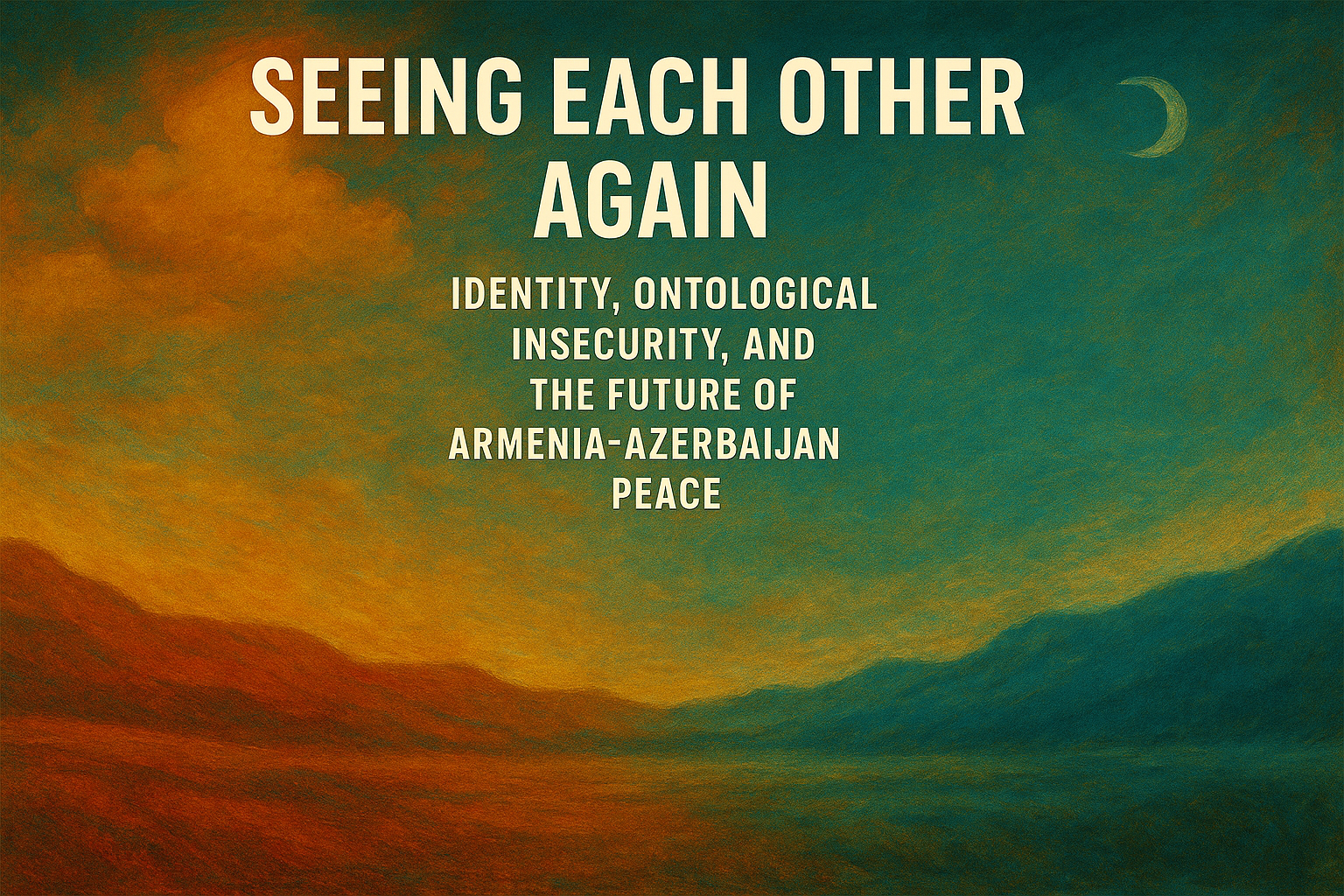Seeing each other again: identity, ontological insecurity, and the future of Armenia-Azerbaijan Peace

The Armenia-Azerbaijan conflict has often been explained in terms of territory and geopolitics. Yet beneath the conflict over territory and recognition lies a struggle over identity and continuity - what scholars call ontological security.
In international relations, ontological security refers to the need of individuals and states to maintain a stable sense of self, to feel that “we know who we are” even amid uncertainty. When that sense of self is threatened, actors seek predictability through familiar routines, even if those routines are harmful. In long-standing conflicts like that between Armenians and Azerbaijanis, enmity itself becomes a source of stability. The “Other” is necessary to know who the “Self” is.
For decades, this dynamic defined the South Caucasus. After the collapse of the Soviet Union, both countries built post-Soviet identities around the Karabakh conflict. Armenia’s statehood narrative centered on defending Karabakh as a symbol of survival against historical persecution. For Azerbaijan, the loss of Karabakh was experienced as national humiliation, a wound demanding rectification. These mirrored narratives were reinforced through textbooks, media, and political discourse. Paradoxically, the “frozen conflict” was a stable routine of mutual antagonism that provided ontological comfort.
As political theorist Jennifer Mitzen has argued, states often cling to even destructive relationships because they sustain identity continuity. And as Bahar Rumelili notes, identities are formed through boundaries with “Others,” producing exclusionary categories that resist transformation. For both Armenia and Azerbaijan, enmity became the habit that made the world feel predictable.
The Second Karabakh War in 2020 upended this equilibrium. For Azerbaijan, military victory became ontological affirmation, the long narrative of victimhood gave way to a triumphant story of restoration and pride. For the first time since independence, Azerbaijan could define itself as victorious rather than humiliated. Yet having built its identity for decades around grievance, Azerbaijan’s new stability still depended on the Armenian “Other.”
For Armenia, the war was an ontological shock. The defeat dismantled a national story rooted in heroic defense and historical survival. Prime Minister Nikol Pashinyan’s attempt to reorient identity around a “Real Armenia”, focused on the state within its recognized borders, was a rational pivot. But it also triggered backlash. To many, it felt like symbolic capitulation, a rupture in the national narrative of resilience.
In ontological terms, Armenia entered a state of liminality, no longer able to perform the old identity of the victorious defender, yet not ready to embrace a new one. Such in-between moments, Rumelili argues, can be either transformative or deeply destabilizing. Armenia’s internal polarization, between those urging acceptance and those demanding revenge, shows precisely that struggle.
Today, the Armenia-Azerbaijan relationship sits in an unstable asymmetry, Azerbaijan enjoys ontological confidence from victory but continues to define itself through the defeated Other, while Armenia grapples with insecurity and narrative collapse. Both remain trapped in conflictual routines that make peace itself feel threatening.
This is the paradox of ontological security. Peace demands new narratives and new routines, yet these are precisely what most societies find hardest to invent. When enmity has long provided stability, coexistence feels like identity loss. Leaders who attempt to reframe the national story, as Pashinyan has tried, face fierce resistance because change threatens collective continuity.
The result is an “ontological security dilemma of peace”: both sides crave stability, but the only stability they know comes from conflict. Material conditions for peace may now exist, but identity anxieties make reconciliation emotionally and politically perilous.
If enmity has been the anchor of identity, the challenge ahead is to build new routines that provide ontological stability without requiring hostility. That means peacebuilding must move beyond the peace agreements and focus on reimagining how Armenians and Azerbaijanis understand themselves and each other.
Armenia and Azerbaijan are now in a rare liminal period: the old order of enmity has cracked, but a new one has yet to take shape. Such moments are dangerous but also transformative. As Rumelili writes, liminality can be the space where fixed identities give way to new forms of being.
If leaders and societies can use this instability to construct alternative routines in education, media, commemoration, and digital cooperation, they may finally anchor their identities in coexistence rather than confrontation. Only when Armenians and Azerbaijanis can experience ontological security without enmity will the region truly move beyond war.
Indeed, the recent visit of Azerbaijani representatives to Armenia, followed by plans for Armenian delegations to travel to Azerbaijan, is a quietly historic moment. For the first time in three decades, citizens of the two nations are seeing each other face-to-face. This might appear modest compared to grand diplomatic summits, but ontologically, it is profound. For thirty years, Armenians and Azerbaijanis have lived in near-total isolation from one another. The Other existed only as an abstraction, an enemy image sustained through memory. In the absence of contact, myth hardened into “truth.” Ontological security, for both societies, depended on never seeing the Other as a human being. That is why these exchanges matter so deeply. The first step toward building peace routines is the normalization of seeing each other. To simply see each other again, to share a meal, to walk the same streets, to listen, begins to reconfigure the emotional architecture of identity. As in Bahar Rumelili’s concept of liminality, transformation begins in moments when old boundaries are suspended and new meanings can emerge. These visits, however limited, create precisely such liminal spaces. In Mitzen’s terms, this offers the beginning of new “routines of contact,” small, repetitive acts that can eventually make coexistence itself feel predictable and safe.
The challenge now is to protect and expand these openings. Such initiatives must not be dismissed; they are the groundwork of ontological stabilization. Each encounter reduces the anxiety that arises from the unknown. Over time, these human-level connections can provide the emotional infrastructure for more formal political reconciliation.







